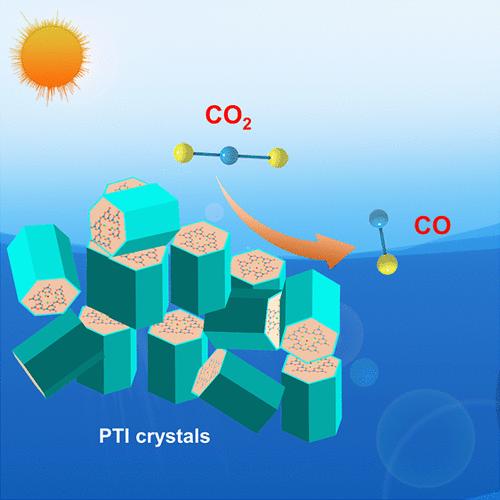Poly(triazine imide) Crystals for Efficient CO2 Photoreduction: Surface Pyridine Nitrogen Dominates the Performance
IF 11.3
1区 化学
Q1 CHEMISTRY, PHYSICAL
引用次数: 0
Abstract
Polymeric carbon nitrides (PCNs), usually the melon phase, have been extensively applied as photocatalysts for CO2 reduction; however, their performance is still unsatisfactory. The condensed allotrope, namely, poly(triazine imide) (PTI) with extended conjugation and a crystallized structure, indeed holds more favorable compositional and structural advantages for photocatalytic CO2 reduction but remains to be fully exploited. Herein, hexagonal prism-shaped PTI crystals were synthesized and developed as a high-performance photocatalyst for CO2 reduction. With Co(bpy)32+ as a cocatalyst, the PTI crystals exhibit a CO evolution rate of 44 μmol h–1 (i.e., 1467 μmol g–1 h–1) with 93% selectivity, markedly superior to that of the melon counterpart. Moreover, PTI crystals manifest an apparent quantum efficiency of 12.9% at 365 nm, representing the state-of-the-art value by PCN photocatalysts for CO2-to-CO reduction without using noble metals. The surface pyridine N species of PTI are exposed as active sites to dominate CO2 activation and conversion, which, together with the high crystallinity to facilitate charge separation and transport, endows high CO2 reduction efficiency. In situ diffuse reflectance infrared Fourier transform spectroscopy determines the key intermediates during the CO2 reduction reaction and, consequently, constructs the possible reaction mechanism.

高效CO2光还原用聚(三嗪亚胺)晶体:表面吡啶氮主导性能
聚合物碳氮化物(PCNs),通常是瓜相,已广泛应用于CO2还原的光催化剂;然而,他们的表现仍然不尽人意。缩合同素异形体,即具有扩展共轭和结晶结构的聚三嗪酰亚胺(PTI),在光催化CO2还原中确实具有更有利的组成和结构优势,但仍有待充分利用。本文合成了六方棱柱状PTI晶体,并开发了一种用于CO2还原的高性能光催化剂。在Co(bpy)32+的助催化剂作用下,PTI晶体Co的析出速率为44 μmol h-1(即1467 μmol g-1 h-1),选择性为93%,明显优于甜瓜晶体。此外,PTI晶体在365 nm处表现出12.9%的表观量子效率,代表了PCN光催化剂在不使用贵金属的情况下将co2还原为co的最新值。PTI的表面吡啶N作为活性位点暴露,主导CO2的活化和转化,再加上高结晶度有利于电荷的分离和传输,使得PTI具有较高的CO2还原效率。原位漫反射红外傅里叶变换光谱测定了CO2还原反应中的关键中间体,从而构建了可能的反应机理。
本文章由计算机程序翻译,如有差异,请以英文原文为准。
求助全文
约1分钟内获得全文
求助全文
来源期刊

ACS Catalysis
CHEMISTRY, PHYSICAL-
CiteScore
20.80
自引率
6.20%
发文量
1253
审稿时长
1.5 months
期刊介绍:
ACS Catalysis is an esteemed journal that publishes original research in the fields of heterogeneous catalysis, molecular catalysis, and biocatalysis. It offers broad coverage across diverse areas such as life sciences, organometallics and synthesis, photochemistry and electrochemistry, drug discovery and synthesis, materials science, environmental protection, polymer discovery and synthesis, and energy and fuels.
The scope of the journal is to showcase innovative work in various aspects of catalysis. This includes new reactions and novel synthetic approaches utilizing known catalysts, the discovery or modification of new catalysts, elucidation of catalytic mechanisms through cutting-edge investigations, practical enhancements of existing processes, as well as conceptual advances in the field. Contributions to ACS Catalysis can encompass both experimental and theoretical research focused on catalytic molecules, macromolecules, and materials that exhibit catalytic turnover.
 求助内容:
求助内容: 应助结果提醒方式:
应助结果提醒方式:


